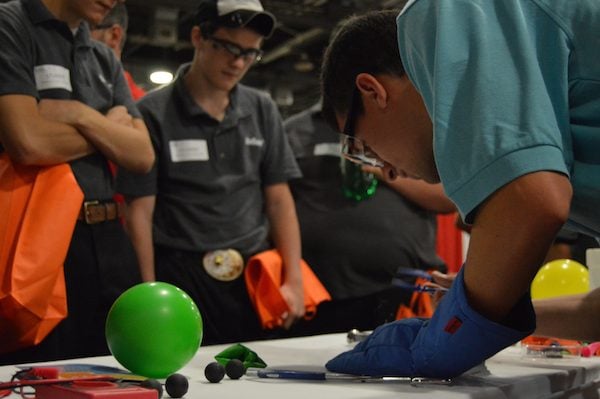
[Image above] ACerS PCSA member Brian Donovan knows the value of materials science communication—here he performs a ceramic superconductor demonstration at MS&T15. Credit: ACerS
Thomson Reuters recently unveiled its newest annual ranking of the world’s hottest researchers—and over 35% of those minds are studying materials.
According to a Thomson Reuters press release, “the 2015 hottest researchers ranking spotlights the scientific community’s emerging trends and 19 innovators, who recently published at least 14 papers with notably high levels of citations. The list was identified by tabulating citations within the Web of Science recorded during calendar year 2014 for papers published between 2012 and 2014.”
Of those 19, seven are scientists studying materials:
- Henry J. Snaith, Oxford University – perovskite solar cells
- Michael Grätzel, École Polytechnique Fédérale de Lausanne – perovskite solar cells
- David (Xiong Wen) Lou, Nanyang Technological University – energy technologies, including lithium batteries and supercapacitors
- Mohammed K. Nazeeruddin, École Polytechnique Fédérale de Lausanne – perovskite solar cells
- Hua Zhang, Nanyang Technological University – nanomaterials, including MOFs, monolayers, and self-assembly
- Yang Yang, Univ. of California, Los Angeles – perovskite solar cells
- Yi Cui, Stanford University – lithium batteries and catalysts
That puts materials science on equal playing ground with genomics—which also had seven scientists on the list—as an emerging trend. Overall, the ranking reveals “significant growth in cancer genomics and improvements in converting solar cells into renewable energy,” according to the release.
In addition to the short list of the year’s hottest researchers, Thomson Reuters also released a longer, more in-depth study of top scientists by field.
That list, known as the Highly Cited Researchers ranking, includes about 3,000 researchers who rank “among the top one percent by citations received in their respective fields in each paper’s year of publication,” according to the same Reuters press release.
About 130 materials scientists make that longer list—flip to page 67 of the report for the full list of highly-cited materials scientists.
But Thomson Reuters isn’t the only awarding institution noticing materials scientists.
The American Association for the Advancement of Science just announced that scientist and science communicator Mark Miodownik is the association’s 2015 Public Engagement with Science Award winner.
[Did you know that ACerS also offers many awards to recognize contributions within the ceramics and glass materials’ community?]

Mark Miodownik examines stuff that matters.
Miodownik, author of the award-winning and NY Times best-selling popular materials science book Stuff Matters, received the award for “his enthusiastic and successful commitment to public engagement, igniting a sense of wonder about the world by unveiling the interplay between science, engineering, and the society,” according to a AAAS press release.
If you’re an ACerS member, you can read my review of the book, published in the March 2015 ACerS Bulletin, here.
In addition to an award-winning book author, Miodownik writes about materials science for several newspapers and news outlets, helping to educate the public about the value and excitement of the discipline.
Miodownik also hosted an excellent BBC television series all about materials engineering called “How it Works.” Watch this short clip from the BBC series, in which Miodownik displays one of our favorite material demonstrations—ceramic superconductors.

Credit: BBC; YouTube
If want more Miodownik, catch this hour-long video of his Friday Evening Discourse presentation to The Royal Institution in 2013. Or watch these highlights of his engaging youth-oriented Christmas Lectures presentation, also at The Royal Institution, in 2010.
Author
April Gocha
CTT Categories
- Education


